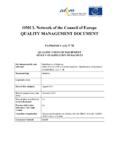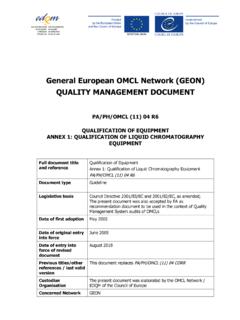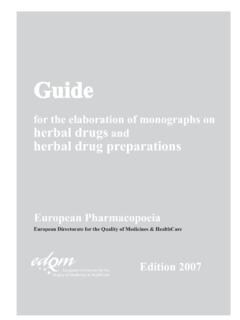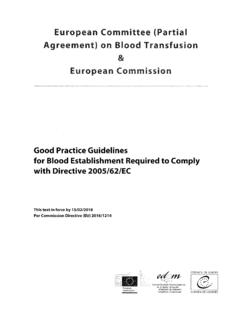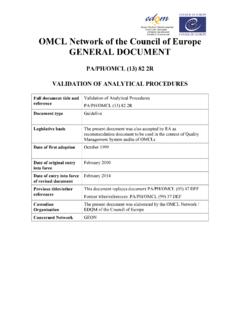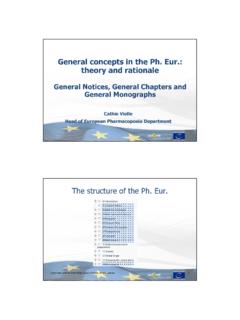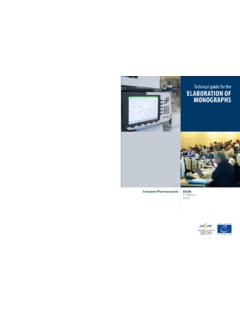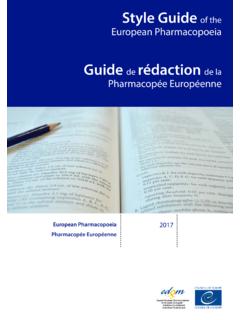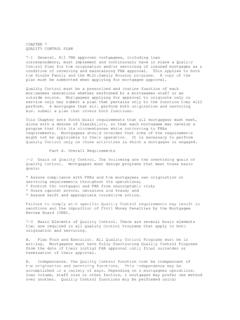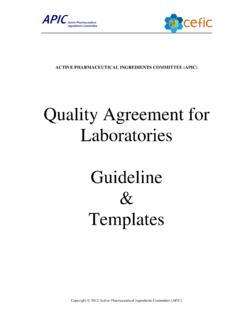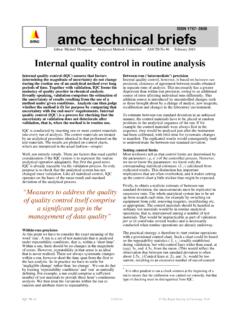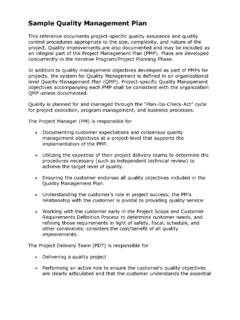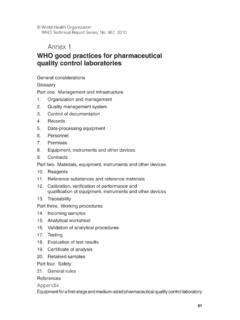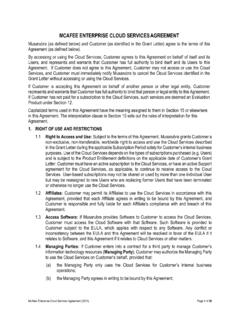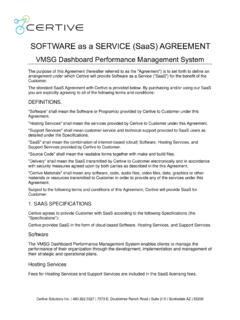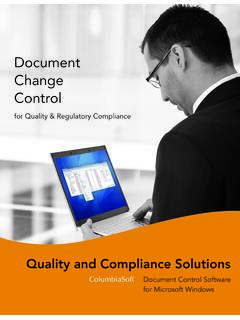Transcription of European Pharmacopoeia Chapter 5.1.6 Alternative methods ...
1 EDQM Symposium on Microbiology10-11 October 201711/10 2017 EDQM, Council of Europe. 2017 EDQM, Council of Europe. All rights reserved. 1 European Pharmacopoeia Chapter methods for control of microbiological qualityS bastien Jouette, Ph. programme officer, European Pharmacopoeia DepartmentEuropean Directorate for the Quality of Medicines and 2017 EDQM, Council of Europe. All rights Alternative methods for control of microbiological quality AIM: to facilitate the implementation anduse of Alternative microbiological methods (AMM) where this can lead to cost-effective microbiological control and improved assurance for the quality of pharmaceutical products. CONTENT: basic principles for detection, enumeration, isolation and identification of the methods which have successfully been used in QC of pharmaceuticals; guidance on validation of Alternative methods against 2017 EDQM, Council of Europe. All rights Symposium on Microbiology10-11 October 201711/10 2017 EDQM, Council of Europe.
2 2017 EDQM, Council of Europe. All rights reserved. and Ph. Eur. General Notices Monographs: mandatory requirements, unless otherwise indicated General chapters: become mandatory when referred to in a monograph, unless such reference is made in a way that indicates that it is not the intention to make the text referred to mandatory but rather to cite it for 2017 EDQM, Council of Europe. All rights and Ph. Eur. General NoticesAlternative methods . The tests and assays described are the official methods upon which the standards of the Pharmacopoeia are based. With the agreement of the competent authority, Alternative methods of analysis may be used for control purposes, provided that the methods used enable an unequivocal decision to be made as to whether compliance with the standards of the monographs would be achieved if the official methods were used. In the event of doubt or dispute, the methods of analysis of the Pharmacopoeia are alone authoritative.
3 2017 EDQM, Council of Europe. All rights Symposium on Microbiology10-11 October 201711/10 2017 EDQM, Council of Europe. 2017 EDQM, Council of Europe. All rights reserved. 3 Revision of Chapter on modern microbiological methods by Ph. Eur. (2010) OUTCOME: Chapter helpful Lots of proposalsfor improvements Validation examples useful Furthervalidation examples should be given KEY ELEMENTS: To give a general view on the use of Alternative microbiological methods in Europe To find out if the contents of the Chapter were appropriate and see if the Chapter needed revision Had the Chapter facilitated the use of Alternative methods ?Input sought from manufacturers and NPAsPublished insupplement (January 2017) 2017 EDQM, Council of Europe. All rights version published in 2006 Pharmeuropa , 2015: > 200 commentsElaboration of the revised Chapter (meetings, drafting, data) ImprovementScope of revision Relevance of Alternative methods toProcess Analytical Technology Update and improved description of the methods Improvementof the section dealing with Process validation : -Clearer structure for primary validation and validation of intended use-Description of tasks to be undertaken for the validation process between supplier and 2017 EDQM, Council of Europe.
4 All rights Symposium on Microbiology10-11 October 201711/10 2017 EDQM, Council of Europe. 2017 EDQM, Council of Europe. All rights reserved. 4 What s new: Chapter StructureFormer version GENERAL INTRODUCTION1. GENERAL PRINCIPLES OF Alternative METHODS2. GENERAL VALIDATION REQUIREMENTS3. SPECIFIC VALIDATION REQUIREMENTSA nnex: Example validation of an Alternative method: detailed protocol followed by a laboratory for the implementation of bioluminescenceNew version1. GENERAL INTRODUCTION2. GENERAL PRINCIPLES OF Alternative OF Alternative MICROBIOLOGICAL METHODSEDQM-Website: EXAMPLES OF VALIDATION FOR Alternative 2017 EDQM, Council of Europe. All rights eliminate potential misinterpretation of the purpose of examplesTo keep it updated with new validatedalternatives methods ** After approval by Ph. Eur commissionWhat s new1. GENERAL INTRODUCTION Adding AMMs for application of Process Analytical Technology(PAT) in-process control and environmental monitoring 3 major types of determination specific to microbiological tests: qualitative tests for the presence or absence of micro-organisms; quantitative tests for enumeration of micro-organisms; identification choice of test is key not all technologies are suitable for all determinations the output signal of the test may be different and requires validation and analysis to determine equivalence validation requirements are determined by the test 2017 EDQM, Council of Europe.
5 All rights Symposium on Microbiology10-11 October 201711/10 2017 EDQM, Council of Europe. 2017 EDQM, Council of Europe. All rights reserved. 59 Growth-based methods , where a detectable signal is usually achieved by a period of : -Measurement of consumption or production of gas-Bioluminescence (ATP) Direct measurement, where individual cells are differentiated and/or : -Solid phase cytometry, flow cytometry-Autofluorescence Cell component analysis, where the expression of specific cell components offers an indirect measure of microbial presence and identification of :-NAT ( PCR, Sequencing)-Mass Spectrometry2. GENERAL PRINCIPLES OF Alternative 2017 EDQM, Council of Europe. All rights the method suitable? Is the method destructive ? Identification may not be possible Can non-viable or viable non-culturable micro-organisms be detected ? Can pure colonies be found ? Will the micro-organisms be present in the reference database used ?
6 What s new2. GENERAL PRINCIPLES OF Alternative methods Some methodshave been removed( , phage-based method) Revisionor additionof methods autofluorescence, LAL as an Alternative to gram staining extensive revision of genotypic methods modification of paragraphs Critical Aspects and Potential Uses General information on identification methods : Databases(included in the primary validation, customisation) Traditional Biochemical & Phenotypic versus Genotypic 2017 EDQM, Council of Europe. All rights Symposium on Microbiology10-11 October 201711/10 2017 EDQM, Council of Europe. 2017 EDQM, Council of Europe. All rights reserved. 6 What s new: Validation of Alternative Microbiological methods Restructuring the Chapter : 3-1. INTRODUCTION3-2. VALIDATION PROCESS3-2-1. Description of the technique3-2-2. Risk-benefit analysis3-2-3. Primary validation3-2-4. Validation for the intended use3-3. TYPES OF MICROBIOLOGICAL TESTS 3-3-1.
7 Validation of Alternative qualitative test for the presence and absence of micro-organisms 3-3-2. Validation of Alternative quantitative tests for enumeration of Validation of Alternative identification tests Risk-benefit analysis Very important to consider the limitations of both the conventional and Alternative method To decide on which Alternative method to be used To understand the impact of the new method Primary validation Primary validation sets out criteria that should be selected by the supplier using a panel of test micro-organismsValidation for the intended use Comprehensive validation for the intended use is set out and includes URS, DQ, IQ, OQ, 2017 EDQM, Council of Europe. All rights Process: tasks and responsabilityTable Tasks to be undertaken during the validation processActivitynormally carried out bySupplierUserPrimary validation+-1 URS (instrument, application)-+Description of the technique+-2 Risk benefit analysis-3+Design Qualification-+Installation Qualification-4+Operational Qualification-4+Performance Qualification: - Verification of primary performance qualification-+- Verification for the intended use ( sterility testing, TAMC/TYMC.)
8 -+Method Suitability Test-+(1) The user performs primary validation if they employ the Alternative method for an use other than that defined by the supplier.(2) The user shall critically review information provided by the supplier.(3) As part of commercialisation, the supplier may list advantages of the Alternative method over conventional techniques.(4) IQ / OQ for complex equipment, IQ/OQ is often outsourced to 2017 EDQM, Council of Europe. All rights Symposium on Microbiology10-11 October 201711/10 2017 EDQM, Council of Europe. 2017 EDQM, Council of Europe. All rights reserved. 7 Validation ProcessPrimary validation1) Supplier 2) User 2017 EDQM, Council of Europe. All rights ProcessValidation for the intended 2017 EDQM, Council of Europe. All rights the functions that the method must be capable of performing: Which kind of analysis are performed? Which sensitivity is needed? Which kind of microorganisms should be detected?
9 Number and kind of analysis Interface with LIMS, CSV, etc. needed? Same results according to predefined criteria Use of a model-system Use of pharmacopoeial test strains, in-house isolates, stressed microorganismsEDQM Symposium on Microbiology10-11 October 201711/10 2017 EDQM, Council of Europe. 2017 EDQM, Council of Europe. All rights reserved. 8 Validation parameters depending on the types of microbiological testsCriterionQualitative testQuantitative testIdentification testAccuracy+1++Precision-+ -Specificity++ +Detection limit+-2-Quantitation limit-+ -Linearity-+ -Range-+ -Robustness++ +Suitability testing++ -Equivalence testing++ -Table Validation criteria for qualitative, quantitative and identification tests1 Performing an accuracy test of the alternate method with respect to the compendial method can be used instead of the validation of the limit of detection may be needed in some 2017 EDQM, Council of Europe.
10 All rights for the intended useSuitability Testing Show the suitability of the AMM in the presence of the product Suitability testing It must show that the test sample does not interfere with the technology's detection capacity or microbial recovery ( or enumeration) Acceptance criteria for the method are defined as a function of the application and of the validation 2017 EDQM, Council of Europe. All rights Symposium on Microbiology10-11 October 201711/10 2017 EDQM, Council of Europe. 2017 EDQM, Council of Europe. All rights reserved. 9 Validation for the intended useEquivalence Testing Conducted directly on the validation parameters Parallel testing with the Alternative method and the compendial method. The result must be equivalentEquivalence testing Sufficient numbers of replicates for relevant strains of test micro-organisms are required Parallel testing is justified by a risk assessment and requires parallel testing of samples for a predefined period of time or a predefined number of samples Results of the Alternative method are equivalent to those of the pharmacopoeial method Further analysis may be 2017 EDQM, Council of Europe.
